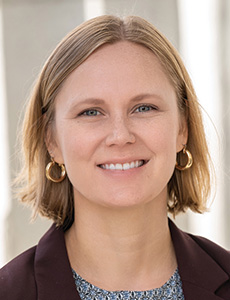
Maeghan Thurston didn’t expect to end up working with captive insurance companies.
In college, she studied marketing. She imagined working in New York City, going to meetings with big ad execs, living in an apartment and taking the subway to work. For a lot of people, that’s the dream. But for Thurston, a true-blue Vermonter, it felt lacking.
She not only wanted a great career, but she also wanted to remain in the state she loved.
So, she added an accounting major to her path of study. That way, she could keep her options open and perhaps remain in Vermont. That decision led her to her current position as an accountant for the captive industry. She’s the audit senior manager with Crowe LLP.
“I definitely wasn’t looking for captives,” Thurston said. “I’ve been able to build a very successful career in the insurance space in Vermont.”
Like Thurston, many students in Vermont don’t know about the excellent career opportunities their state’s captives industry offers. While Vermont is the largest captive domicile globally, it struggles to attract talent — as do many insurance firms. “I was beginning to realize, in my three years in the industry, that we really needed to do something about this, because there were people retiring at a much faster rate than people were entering,” said Brittany Nevins, captive insurance economic development director for the Vermont Department of Economic Development.
Enter the Vermont Captives Insurance Emerging Leaders group (VCIEL). Launched in April 2022 in affiliation with the Vermont Captive Insurance Association (VCIA) and the Vermont Department of Economic Development, the group has helped educate young people about career opportunities in the industry and is encouraging universities in Vermont to establish insurance curricula.
One year in, let’s take a look at how the VCIEL is doing.
Next generation captive talent

The VCIEL is tackling the captive insurance talent issue from a number of different angles.
The group has three committees — education, networking, and resource and marketing. The group reaches students in the classroom and at networking events and considers how the industry could better market itself to bring others into the fold.
Each year, the VCIA holds an annual conference, and the VCIEL has worked to create a student sponsorship for the event in order to educate more students about captive careers.
Peter Dysart is an associate attorney with Primmer, Piper, Eggleston & Cramer PC, which works in the captive insurance space. He spoke at last year’s event and believes it’s important for students to see young people like him building their careers in the industry. “It was a great opportunity, not only for me professionally, but also to continue to promote the industry,” Dysart said.
Another way the group reaches students is through its networking events. They try to hold at least two per year. Last year, they held one at Pizza 44 in Burlington and did a professional “speed dating” round where students could ask professionals in the various roles in the industry questions about their career paths.
“It was a fun opportunity for me to talk to younger students and people entering the profession about what I do and what the captive industry is about,” Dysart said.
Great careers, great place to call home
From actuaries and attorneys to risk managers, regulators and others, a career path in captive insurance can extend across a number of different segments.
Students can come to the industry from a variety of different majors and educational paths. Vermont’s well-educated and diverse set of talent is part of what has made it the largest domicile globally.
“We got there by having very smart, talented and knowledgeable people in this industry who can meet the needs of both the companies and the regulators,” Thurston said.
“I was beginning to realize … that we really needed to do something about this, because there were people retiring at a much faster rate than people were entering,” — Brittany Nevins, captive insurance economic development director, Vermont Department of Economic Development
One way the group has been able to educate Vermonters about careers in the industry is through being transparent about how many jobs are out there and how well-paying they are. According to Nevins, there’s about 400 positions across the various sectors that house captive insurance jobs in Vermont. These positions pay salaries averaging $92,000 per year.
“There’s a lot of opportunities for students and young professionals here,” said Sherri Stuebing, a member of the VCIEL group.
Students and early-career professionals aren’t the only jobseekers VCIEL tries to reach. The group is also interested in connecting with people who might be looking to make a career pivot.
“We’re trying to educate folks at the college level, and also individuals who may be interested in making a career change,” said Peter Wernhoff, examiner-in-charge with the Vermont Department of Financial Regulation.
VCIEL’s goal is to keep as many people in Vermont as possible, but people interested in captives should know that it’s truly a career with international prospects. It’s a vocation that can help people build the kind of big careers Thurston thought were only possible in New York City.
“The long-term vision is to structurally change the way captive insurance and risk management is available on higher ed syllabi … The earlier [students] get exposed to a career path, the more they’ll prioritize it.”
— Francis McGill, senior director of marketing, Vermont Captive Insurance Association
“The reality is, there’s captive legislation in almost 40 states, which means that there’s captive jobs all over the U.S. and internationally,” Stuebing said.
Still, many Vermonters appreciate that the industry gives them the opportunity to be successful and remain in their state. They like that they’re close to hiking, snowshoeing and skiing, so that when they get up from their desks at the end of a workday, they can get outside and enjoy everything the state has to offer.
“There’s great career opportunities, and you’re still able to be a Vermonter on the weekends,” Thurston said.
Looking to the future: Bringing captives to schools

The VCIEL’s long-term goal is to help get captives curricula into colleges and universities in the state. By making it an educational track for students, the organization hopes that more students will know the benefits of and pursue careers in the industry.
“The long-term vision is to structurally change the way captive insurance and risk management is available on higher-ed syllabi,” said Francis McGill, senior director of marketing for the VCIA. “The earlier [students] get exposed to a career path, the more they’ll prioritize it.”
Many in the VCIEL believe the benefits of captive insurance curricula at Vermont colleges and universities are intuitive. Captives are a major career opportunity in the state. It’s surprising that local colleges and universities haven’t developed majors and minors around this field.
That’s slowly changing. The VCIEL has been proactive about reaching out to local institutions of higher education and outlining the benefits of captive insurance careers. “We’ve made a lot of inroads with people at some of the universities and colleges in the area,” Stuebing said.
One way the VCIEL has been able to bring educational institutions into its mission is through internships. Colleges and universities told the group that students are always searching for internship prospects, but opportunities within captives haven’t been centralized and easy to find in the past. So the VCIEL is creating an internship roster. They’ve found about a dozen opportunities so far in Vermont.
“One thing we consistently hear from colleges is they want to see internship opportunities,” McGill said.
Working with educational institutions to teach students about opportunities in the captive industry will allow more people to pursue the career intentionally. Gone will be the clichéd stories of people accidentally stumbling upon the industry. More people will be like Dysart, who chose the career path intentionally because his stepfather worked in captives law.
“We’ve seen a significant amount of growth in the student knowledge base,” Thurston said. “This group is really helping people make more intentional and informed decisions by teaching them about these good careers out there.”
To achieve this mission and recruit the next generation of Vermont captive talent, many people will need to work together. The VCIEL believes it can play a key role in bringing people together and actualizing these goals and inspiring other domiciles to do the same.
“No one person can make a difference alone,” Nevins said. “We really needed 30 people in our state in the industry that are emerging leaders to actually make a difference.”


